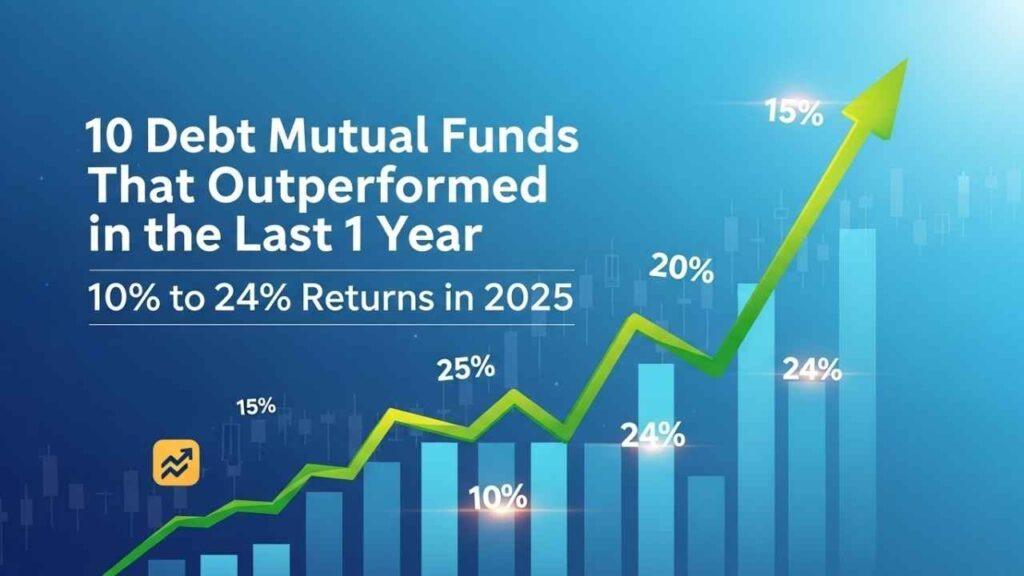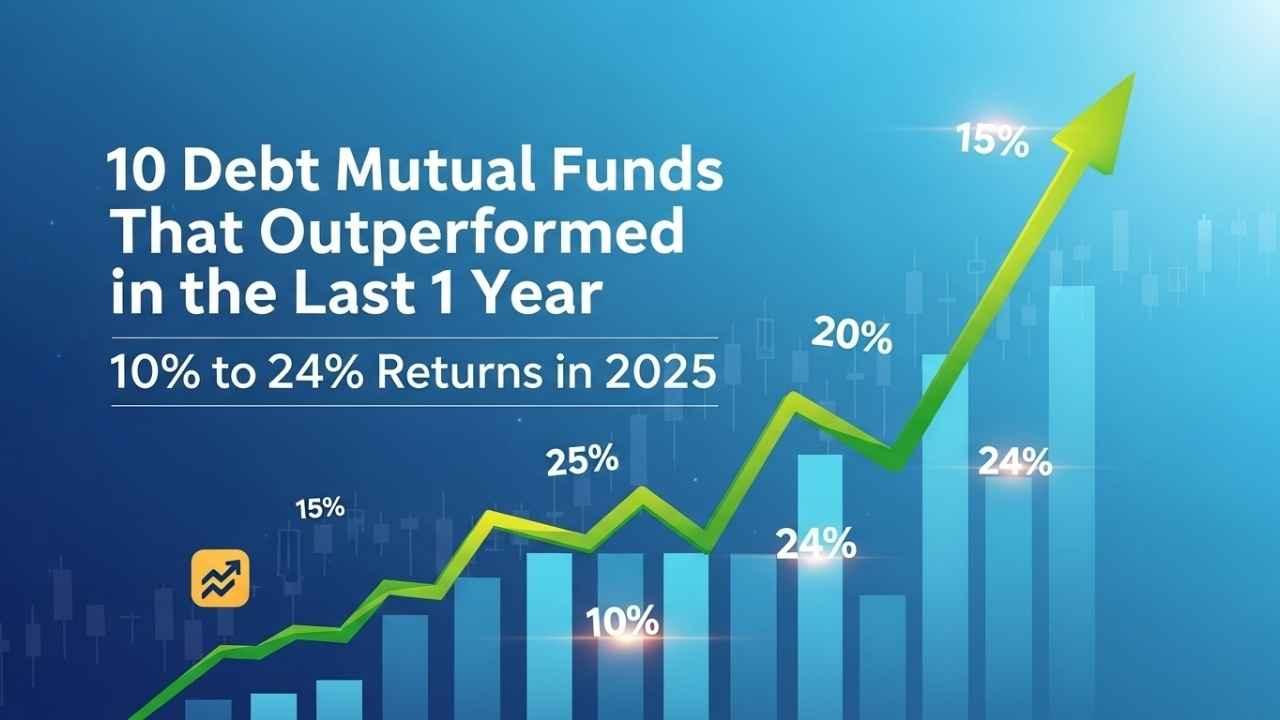If you’re interested in parking your money in something less risky than stocks but still desire reasonable returns, debt mutual funds could be on your priority list. They’re investment avenues that primarily invest in fixed-income papers such as bonds, government securities, and corporate debt. They’re sought after since they provide stability, a steady income, and low risk compared to equity funds – ideal for conservative investors or those creating an emergency fund.
In 2025, when interest rates have been volatile and the economy is showing a recovery after some global uncertainty, debt funds have been coming back into form. Several of them have produced stellar returns in the last year, between about 10% and almost 23%. Not so bad for “safe” investments! Today, I’m presenting you with a list of the top 10 debt mutual funds that have performed better in the past 1 year, as of August 21, 2025. These funds have provided returns ranging from 10.13% to 22.93%, far higher than what a traditional savings account would offer.
Whether you’re an amateur investor or one making adjustments to your portfolio, this article will have it simplified for you. I’ll tell you what these funds are, identify the best performers, and provide you with some pointers on how to select and invest judiciously.
What Are Debt Mutual Funds and Why Are They Shining in 2025?
A pre-list primer: Debt mutual funds hold debt securities that yield fixed interest. It’s like lending money to a company or the government via bonds. The income is through interest payments and any rise in price if rates decline.
In 2025, a few things have helped push these funds:
- Declining interest in some markets, which makes bonds more valuable.
- Solid credit quality of corporate bonds, lowering default risks.
- Economic stability resulting in improved yields on medium-term and credit risk funds.
But don’t forget, past performance is not necessarily indicative of future results. Such funds can still be subject to risks such as interest rate fluctuations or defaults on credit. Always pair them with your objectives – short-term savings or long-term wealth creation.
Now, to the stars of the show: the top 10 debt mutual funds by their 1-year returns.
Top 10 Debt Mutual Funds with Impressive 1-Year Returns
Here is the handpicked list of funds that have performed well in the past year. I’ve listed them in order from highest to lowest return percentage. Numbers are as of August 21, 2025, so it’s recent and useful for your 2025 investment plans.

| Rank | Mutual Fund Scheme | 1-Year Return (%) |
|---|---|---|
| 1 | DSP Credit Risk Fund | 22.93 |
| 2 | HSBC Credit Risk Fund | 21.68 |
| 3 | Aditya Birla Sun Life Credit Risk Fund | 17.40 |
| 4 | Aditya Birla Sun Life Medium Term Plan | 13.81 |
| 5 | Franklin India Income Plus Arbitrage Active FoF | 13.80 |
| 6 | Nippon India Medium Duration Fund | 11.00 |
| 7 | Invesco India Credit Risk Fund | 10.72 |
| 8 | Nippon India Credit Risk Fund | 10.34 |
| 9 | Franklin India Corporate Debt Fund | 10.21 |
| 10 | Bank of India Short Term Income Fund | 10.13 |
These returns are averaged out annually, so if you had invested last year, this is approximately what you’d have made. Pay attention to how credit risk funds occupy the top rankings – they assume a little more risk by investing in lower-rated bonds to gain higher yields. Medium-term and corporate debt funds come next, providing a mix of safety and growth.
For instance, the top DSP Credit Risk Fund has almost 23% return, which is outstanding for a debt fund. It must have gained from astute selection of high-yield credits. Conversely, others, such as Franklin India Corporate Debt Fund emphasize high-quality corporate bonds, returning stable but lower returns of about 10%.
Breaking Down the Categories: Which Type Suits You?
To make it more useful, let’s categorize these funds by style:
- Credit Risk Funds (Higher Risk, Higher Reward): These constitute the bulk of the list, such as DSP, HSBC, Aditya Birla Sun Life Credit Risk, Invesco, and Nippon India Credit Risk. They invest in bonds rated AA or lower for sweeter returns. Best if you can stomach some volatility and are looking for 10-20%+ returns.
- Medium-Term/Duration Funds: The Aditya Birla Sun Life Medium Term Plan and Nippon India Medium Duration hold bonds with a maturity period of 3-5 years. They’re ideal for moderately risk-taking investors seeking returns of 11-14%.
- Corporate Debt and Short-Term Funds: Franklin India Corporate Debt and Bank of India Short Term Income invest in safer, high-grade bonds. Returns are around 10%, ideal for keeping capital intact with a bit of income.
- Hybrid/ Arbitrage FoF: The Franklin India Income Plus Arbitrage Active FoF mixes debt with arbitrage strategies (profiting from price differences). It’s a unique one here, blending safety with a bit of equity-like tactics for around 13.8% returns.
Pro tip: Check the fund’s expense ratio (fees) and credit quality ratings before investing. Lower fees mean more money in your pocket!
Why Did These Funds Outperform in 2025?
On the basis of trends in the market this year, some of the reasons that emerged are:
- Cut in Interest Rates: Central banks lowering interest rates have increased bond prices, and fund NAVs (Net Asset Values) improved.
- Recovery in Economy: Improved corporate earnings lowered default risks, particularly in credit funds.
- Taming Inflation: Since inflation settled down, fixed-income investments proved better than volatile stocks.
Yet, 2025 has not been smooth sailing – geopolitical tensions and fear of rate hikes may affect future performance. Always diversify: Do not put all eggs in one fund.
Tips for Investing in Debt Mutual Funds in 2025
Ready to invest? Read on for easy, actionable tips to sidestep common mistakes:
- Test Your Risk Appetite: New to the game? Begin with corporate or short-term funds. Seasoned pro? Credit risk for better returns is the way to go.
- Regular Investing through SIPs: Invest a fixed amount every month through Systematic Investment Plan (SIP) to smooth out expenses.
- Fund Details: See the holdings in the portfolio, track record of the manager, and exit charges on platforms like Groww or Zerodha.
- Tax Implications: Debt fund gains are taxed according to your income slab if held below 3 years; long-term receives indexation advantage.
- Monitor and Rebalance: Check your investments every quarter. If interest rates increase, short-term money may do well.
- Diversify Across Funds: Select 2-3 from the above list by categories to diversify risk.
Keep in mind, these are recommendations – seek a financial planner for specific advice.
Final Thoughts: Is Now the Time to Invest?
2025 has been a good year for debt mutual funds, with these top 10 giving 10% to 23% returns – testament that conservative investments don’t have to be dull. If you’re looking for stability with growth prospects, funds such as DSP Credit Risk or Aditya Birla Sun Life may be worth investigating.
But investing is individual. Do your research, keep up with the latest changes in the market, and invest what you can afford to keep for the long term. If you’ve already invested in any of these or have concerns, leave a comment below – I’d appreciate hearing your opinions!
Best wishes for happy investing, and may you grow your wealth intelligently in 2025!
Disclaimer: This blog post is for general informational purposes and not investment advice. Investments in mutual funds are at market risk. Read the scheme documents cautiously before investing. Figures sourced as of August 21, 2025 – always check the latest numbers from credible sources.











